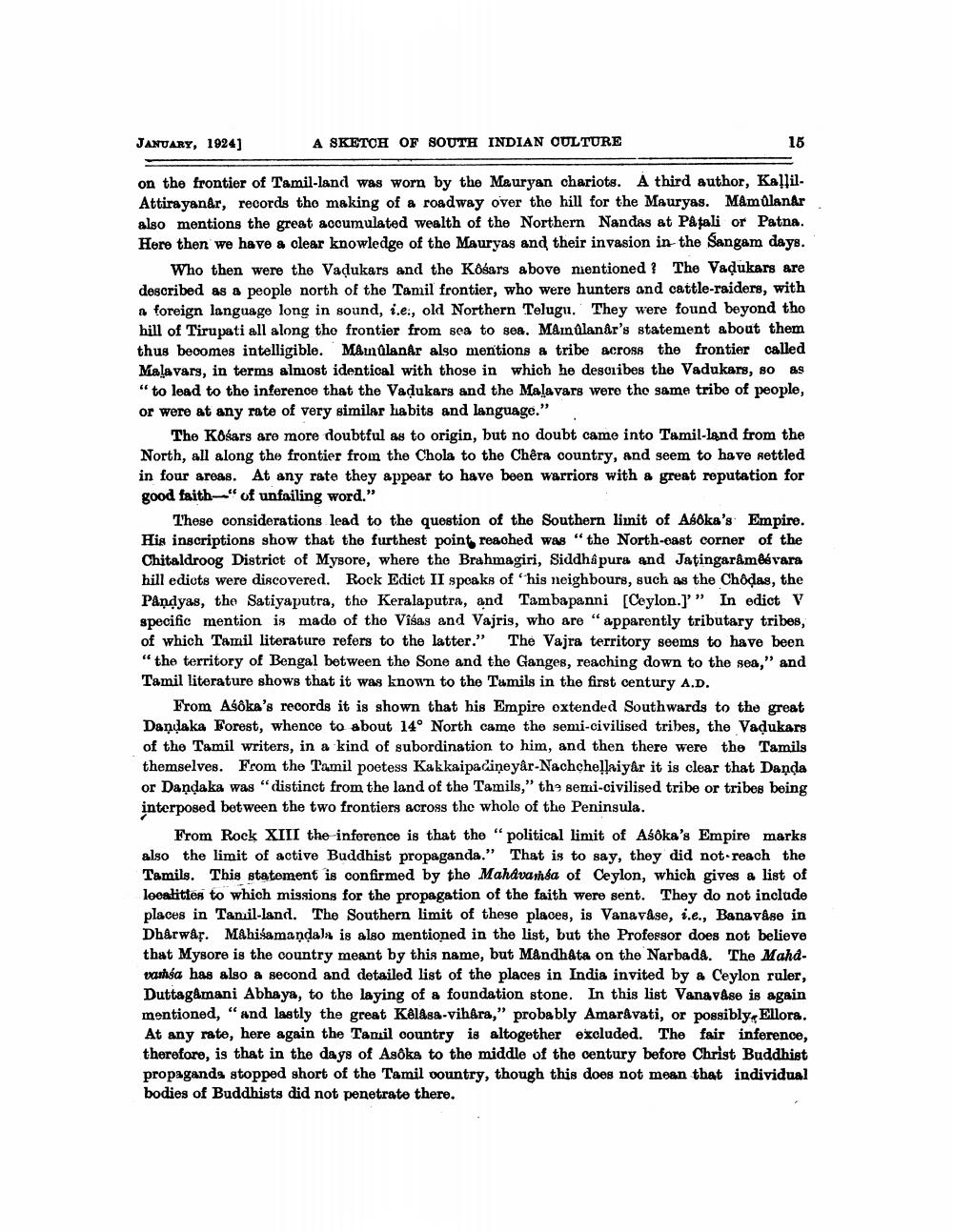________________
JANUARY, 1924)
A SKETCH OF SOUTH INDIAN CULTURE
15
on the frontier of Tamil-land was worn by the Mauryan chariote. A third author, Kallil. Attirayanar, records tho making of a roadway over the hill for the Mauryas. Mamlanar also mentions the great accumulated wealth of the Northern Nandas at Patali or Patna. Here then we have a clear knowledge of the Mauryas and their invasion in the Sangam days.
Who then were the Vadukars and the Košars above mentioned ? The Vadukars are described as a people north of the Tamil frontier, who were hunters and cattle-raiders, with a foreign language long in sound, i.e., old Northern Telugu, They were found beyond tho hill of Tirupati all along the frontier from sea to sea. Mamulanår's statement about them thus becomes intelligible. Maulanar also mentions a tribe across the frontier called Malavars, in terms almost identical with those in which he describes the Vadukars, 80 89 " to lead to the inference that the Vadukars and the Mala vars were the same tribe of people, or were at any rate of very similar habits and language."
The Kosars are more doubtful as to origin, but no doubt came into Tamil-land from the North, all along the frontier from the Chola to the Chêra country, and seem to have settled in four areas. At any rate they appear to have been warriors with a great reputation for good faith" of unfailing word."
These considerations lead to the question of the Southern limit of Asoka's Empire. His inscriptions show that the furthest point reached was "the North-east corner of the Chitaldroog District of Mysore, where the Brahmagiri, Siddhapura and Jatingarámávara hill edicts were discovered. Rock Edict II speaks of his neighbours, such as the Chodas, the Påndyas, the Satiyaputra, the Keralaputra, and Tambapanni [Ceylon.]'” In edict V specific mention is made of the Visas and Vajris, who are "apparently tributary tribes, of which Tamil literature refers to the latter." The Vajra territory seems to have been "the territory of Bengal between the Sone and the Ganges, reaching down to the sea," and Tamil literature shows that it was known to the Tamils in the first century A.D.
From Asöka's records it is shown that his Empire oxtended Southwards to the great Dandaka Forest, whence to about 14° North came the semi-civilised tribes, the Vadukars of the Tamil writers, in a kind of subordination to him, and then there were the Tamils themselves. From the Tamil poetess Kakkaipaciņeyår-Nachchellaiyar it is clear that Dança or Dandaka was "distinct from the land of the Tamils," the semi-civilised tribe or tribes being interposed between the two frontiers across the wholo of the Peninsula.
From Rock XIII the inforence is that the political limit of Asoka's Empire marks also the limit of active Buddhist propaganda." That is to say, they did not reach the Tamils. This statement is confirmed by the Mahavamsa of Ceylon, which gives a list of localities to which missions for the propagation of the faith were sent. They do not include places in Tamil-land. The Southern limit of these places, is Vanavase, i.e., Banavåse in Dharwår. Mahisamandala is also mentioned in the list, but the Professor does not believe that Mysore is the country meant by this name, but Mandhata on the Narbada. The Mahavama has also a second and detailed list of the places in India invited by a Ceylon ruler, Duttagamani Abhaya, to the laying of a foundation stone. In this list Vanavese is again mentioned, "and lastly the great Kelasa-vih&ra," probably Amaravati, or possibly Ellora. At any rate, here again the Tamil country is altogether excluded. The fair inference, therefore, is that in the days of Asôks to the middle of the century before Christ Buddhist propaganda atopped short of the Tamil country, though this does not mean that individual bodies of Buddhists did not penetrate there.




